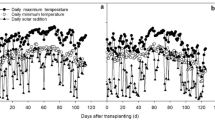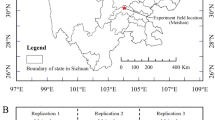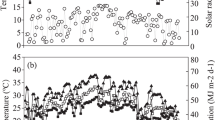Abstract
Germplasm with shorter duration than that of the currently grown varieties is being generated to maximize productivity of irrigated rice. However, short-duration varieties often produce yields lower than the medium- and long-duration varieties. Experiments were conducted during the 1980–82 dry and wet seasons to increase productivity through the use of very early-maturing rices and the improved management of nitrogen (N) fertilizers.
Results over three years showed that IR58 and IR9729-67-3 (growth duration 100 ± 5 days) yield as well as or higher than IR36 although earlier maturing. They generally had a higher productivity (kg ha−1 day−1) than IR36 (110 ± 5 days).
Three years' data suggest that the improved timing of broadcast applications of urea in split doses increased grain yield comparable with the basal incorporation of slow-release sulfur-coated urea (SCU) or deep point-placement of urea supergranules (USG).
Results on elite breeding lines showed that the early-maturing IR9729-67-3 produced higher protein yield ha−1 than longer duration varieties such as IR8 and IR42 in the dry season. Furthermore, contrary to earlier results, single basal incorporation of slow-release SCU increased the protein yield of rice by 53 kg ha−1 and deep point-placement of USG by 43 kg ha−1 over split application of prilled urea.
Similar content being viewed by others
References
Chang TT (1964) Varietal differences in lodging resistance. Int Rice Comm Newslett 13, 1–11
De Datta SK (1981) Principles and practices of rice production. New York: John Wiley and Sons, 618 p
De Datta SK, Obcemea WN and Jana RK (1972) Protein content of rice grains as affected by nitrogen fertilizer and some triazines and substituted ureas. Agron J 64, 785–788
Gomez KA and De Datta SK (1975) Influence of environment on protein content of rice. Agron J, 67, 565–568
Gomez KA and Gomez AA (1976) Statistical procedures for agricultural research, with emphasis on rice. International Rice Research Institute, Los Ba1os, Philippines. 294 p
Grafius JE and Brown HM (1954) Lodging resistance in oats. Agron J 46, 414–418
Herdt RW (1982) Facts about the Philippine sector. Paper presented at the 28th Ann Conv Philipp Agric Econ and Devt Assn, 4 June 1982, Manila, Philippines
International Rice Research Institute (1979) Annual report for 1978. Los Banos, Philippines
International Rice Research Institute (1980) Annual report for 1979. Los Banos, Philippines
International Rice Research Institute (1981) Annual report for 1980. Los Banos, Philippines
Nanda JS and Coffman WR (1979) IRRI's efforts to improve the protein content of rice. In International Rice Research Institute. Proc of the Workshop on Chemical Aspects of Rice Grain Quality, pp. 33–47 Los Banos, Philippines
Tanaka A, Navasero SA, Garcia CV, Parao FT and Ramirez E (1964) Growth habit of the rice plant in the tropics and its effect on nitrogen response. II. Relationship of varietal characters to nitrogen response with special emphasis on mutual shading. International Rice Research Institute Tech Bull 3,29–76
Author information
Authors and Affiliations
Rights and permissions
About this article
Cite this article
Calabio, J., De Datta, S. Increasing productivity and protein content using early-maturing rices and efficient nitrogen management. Fertilizer Research 6, 73–84 (1985). https://doi.org/10.1007/BF01058166
Accepted:
Issue Date:
DOI: https://doi.org/10.1007/BF01058166




